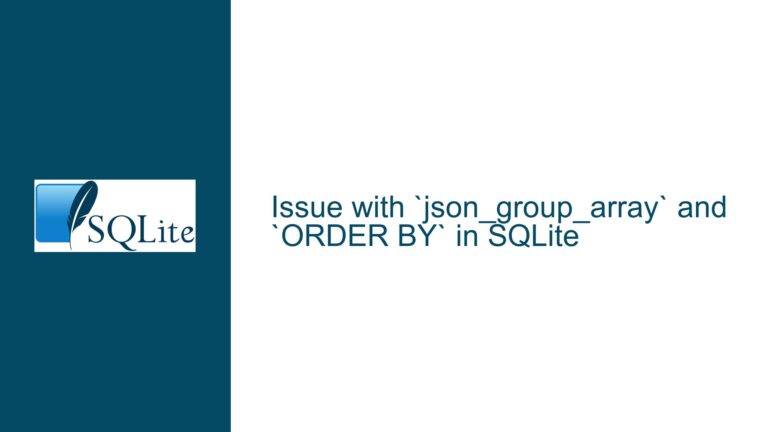Inserting Latest Row ID from One Table into Another with User Inputs in SQLite
Understanding the Problem: Inserting Latest Row ID and User Inputs into a Second Table
The core issue revolves around inserting data into two related tables in SQLite. Specifically, the goal is to insert the latest row ID from table_1 (or cogs in the extended example) into a column in table_2 (or goods), along with additional user-provided values. This operation is triggered by a button click in a PyQt5 application. The challenge lies in ensuring that the latest id from table_1 is correctly fetched and inserted into table_2 alongside new user inputs, all within a single transaction to maintain data integrity.
The problem becomes more complex when considering the extended example involving four tables (Daily_Transaction, cogs, goods, and user). Here, the focus is on inserting the latest cogs_id from the cogs table into the reference column of the goods table, along with user inputs for item_name, item_description, item_code, cost_price, and quantity. The issue is compounded by a mismatch in the number of parameters expected versus those supplied in the SQL query, leading to execution errors.
Identifying the Root Causes: Why the Insert Operation Fails
The primary cause of the issue is the mismatch between the number of columns in the INSERT INTO statement and the number of values provided in the query. In the extended example, the goods table has seven columns (reference, item_id, item_name, item_code, item_description, purchase_date, and quantity), but only five values are supplied in the query. This discrepancy results in an SQL execution error, as SQLite expects a value for each column specified in the INSERT INTO statement.
Another potential cause is the reliance on the max(cogs_id) function to fetch the latest cogs_id from the cogs table. While this approach works in simple scenarios, it may not be robust in a multi-user environment where concurrent inserts could lead to race conditions. Without proper transaction handling, there is a risk of inserting an incorrect or outdated cogs_id into the goods table.
Additionally, the use of AUTOINCREMENT in the primary key definition of cogs and goods tables, while ensuring unique IDs, may not be necessary. SQLite automatically assigns a unique ROWID to each row, and using AUTOINCREMENT can lead to unnecessary overhead. This is particularly relevant when considering the reuse of deleted row IDs, which can complicate the retrieval of the latest cogs_id.
Step-by-Step Solutions and Fixes: Ensuring Correct Data Insertion
To resolve the issue, we need to address the parameter mismatch, ensure robust retrieval of the latest cogs_id, and implement proper transaction handling. Here’s a detailed step-by-step guide to achieve this:
Step 1: Correcting the Parameter Mismatch
The first step is to ensure that the number of values supplied in the INSERT INTO statement matches the number of columns in the goods table. In the extended example, the goods table has seven columns, but only five values are provided. To fix this, we need to include values for all columns, including purchase_date, which appears to be missing from the user inputs.
Here’s the corrected query:
c.execute("INSERT INTO goods (reference, item_name, item_description, item_code, cost_price, quantity, purchase_date) SELECT max(cogs_id), ?, ?, ?, ?, ?, ? FROM cogs",
(itemName, itemDesc, itemCode, itemCP, itemQnty, purchaseDate))
In this query, purchaseDate is a new variable that should be populated with the appropriate value, either from user input or a default value (e.g., the current date).
Step 2: Ensuring Robust Retrieval of the Latest cogs_id
Instead of relying on max(cogs_id), which may not be thread-safe in a multi-user environment, we can use SQLite’s last_insert_rowid() function. This function returns the ROWID of the most recent INSERT operation within the same database connection, ensuring that we get the correct cogs_id even if other inserts occur concurrently.
To use last_insert_rowid(), we need to perform the insert into the cogs table and then immediately fetch the cogs_id before inserting into the goods table. This can be done within the same transaction to maintain data integrity.
Here’s how to implement this:
conn = sqlite3.connect('dawr.db')
c = conn.cursor()
# Insert into cogs table
VAT = self.txt_vat.text()
GST = self.txt_gst.text()
other_taxes = self.txt_other_tax.text()
labor_cost = self.txt_labor_cost.text()
transportation_cost = self.txt_transport_cost.text()
surcharge = self.txt_surcharge.text()
c.execute(
"INSERT INTO cogs(VAT, GST, other_taxes, labor_cost, transportation_cost, surcharge) VALUES (?,?,?,?,?,?)",
(VAT, GST, other_taxes, labor_cost, transportation_cost, surcharge)
)
# Fetch the last inserted cogs_id
cogs_id = c.lastrowid
# Insert into goods table with the fetched cogs_id
itemName = self.lineEdit_3.text()
itemDesc = self.lineEdit_6.text()
itemCode = self.lineEdit_11.text()
itemCP = self.txt_cost_price.text()
itemQnty = self.txt_quantity.text()
purchaseDate = self.get_purchase_date() # Assuming this method returns the purchase date
c.execute(
"INSERT INTO goods (reference, item_name, item_description, item_code, cost_price, quantity, purchase_date) VALUES (?, ?, ?, ?, ?, ?, ?)",
(cogs_id, itemName, itemDesc, itemCode, itemCP, itemQnty, purchaseDate)
)
conn.commit()
conn.close()
In this implementation, c.lastrowid is used to fetch the cogs_id immediately after the insert into the cogs table. This ensures that the correct cogs_id is used when inserting into the goods table.
Step 3: Implementing Transaction Handling
To ensure data integrity, especially in a multi-user environment, it’s crucial to perform both inserts within the same transaction. This prevents other inserts from occurring between the two operations, which could lead to inconsistencies.
SQLite supports transactions using the BEGIN, COMMIT, and ROLLBACK statements. In Python’s sqlite3 module, transactions are automatically managed using the connection object. By default, sqlite3 starts a transaction before executing any SQL statement and commits it after the statement is executed. However, we can explicitly control the transaction to ensure atomicity.
Here’s how to implement explicit transaction handling:
conn = sqlite3.connect('dawr.db')
c = conn.cursor()
try:
# Start a new transaction
conn.execute("BEGIN")
# Insert into cogs table
VAT = self.txt_vat.text()
GST = self.txt_gst.text()
other_taxes = self.txt_other_tax.text()
labor_cost = self.txt_labor_cost.text()
transportation_cost = self.txt_transport_cost.text()
surcharge = self.txt_surcharge.text()
c.execute(
"INSERT INTO cogs(VAT, GST, other_taxes, labor_cost, transportation_cost, surcharge) VALUES (?,?,?,?,?,?)",
(VAT, GST, other_taxes, labor_cost, transportation_cost, surcharge)
)
# Fetch the last inserted cogs_id
cogs_id = c.lastrowid
# Insert into goods table with the fetched cogs_id
itemName = self.lineEdit_3.text()
itemDesc = self.lineEdit_6.text()
itemCode = self.lineEdit_11.text()
itemCP = self.txt_cost_price.text()
itemQnty = self.txt_quantity.text()
purchaseDate = self.get_purchase_date() # Assuming this method returns the purchase date
c.execute(
"INSERT INTO goods (reference, item_name, item_description, item_code, cost_price, quantity, purchase_date) VALUES (?, ?, ?, ?, ?, ?, ?)",
(cogs_id, itemName, itemDesc, itemCode, itemCP, itemQnty, purchaseDate)
)
# Commit the transaction
conn.commit()
except Exception as e:
# Rollback the transaction in case of any error
conn.rollback()
raise e
finally:
# Close the connection
conn.close()
In this implementation, the BEGIN statement starts a new transaction, and COMMIT is used to save the changes. If any error occurs during the execution of the SQL statements, the ROLLBACK statement is executed to undo any changes made within the transaction. This ensures that either both inserts are successful, or neither is applied, maintaining data integrity.
Step 4: Optimizing the Schema Design
While the immediate issue is resolved, it’s worth considering some optimizations to the schema design to prevent similar issues in the future. Specifically, the use of AUTOINCREMENT in the primary key definition of the cogs and goods tables may not be necessary. SQLite automatically assigns a unique ROWID to each row, and using AUTOINCREMENT can lead to unnecessary overhead.
Here’s an optimized schema for the cogs table:
CREATE TABLE "cogs" (
"cogs_id" INTEGER PRIMARY KEY,
"VAT" INTEGER,
"GST" INTEGER,
"other_taxes" INTEGER,
"labor_cost" INTEGER,
"transportation_cost" INTEGER,
"surcharge" INTEGER
);
In this schema, the cogs_id column is defined as the primary key without the AUTOINCREMENT keyword. SQLite will automatically assign a unique ROWID to each new row, which can be fetched using last_insert_rowid().
Similarly, the goods table can be optimized as follows:
CREATE TABLE "goods" (
"reference" INTEGER,
"item_id" INTEGER PRIMARY KEY,
"item_name" TEXT NOT NULL UNIQUE,
"item_code" TEXT UNIQUE,
"item_description" TEXT,
"purchase_date" TEXT,
"quantity" INTEGER NOT NULL
);
In this schema, the item_id column is defined as the primary key without AUTOINCREMENT, allowing SQLite to manage the ROWID assignment automatically.
Step 5: Testing and Validation
After implementing the fixes and optimizations, it’s crucial to thoroughly test the solution to ensure that it works as expected. This includes testing in a multi-user environment to verify that concurrent inserts do not lead to race conditions or data inconsistencies.
Here’s a sample test scenario:
Single User Insert: Verify that inserting a new record into the
cogstable and then inserting related records into thegoodstable works correctly, with the correctcogs_idbeing used in thereferencecolumn of thegoodstable.Concurrent Inserts: Simulate multiple users inserting records into the
cogsandgoodstables simultaneously to ensure that thelast_insert_rowid()function correctly retrieves thecogs_idfor each user’s transaction.Error Handling: Test the transaction handling by introducing errors (e.g., invalid data types) during the insert operations to verify that the
ROLLBACKmechanism works as expected and that no partial data is committed to the database.Performance Testing: Measure the performance of the insert operations, especially in scenarios with a high volume of concurrent inserts, to ensure that the solution scales well.
By following these steps, you can ensure that the solution is robust, reliable, and performs well under various conditions.
Conclusion
The issue of inserting the latest row ID from one table into another, along with user inputs, is a common challenge in database development. By addressing the parameter mismatch, ensuring robust retrieval of the latest row ID, implementing proper transaction handling, optimizing the schema design, and thoroughly testing the solution, you can achieve a reliable and efficient implementation. This approach not only resolves the immediate issue but also sets a foundation for best practices in database development with SQLite.






